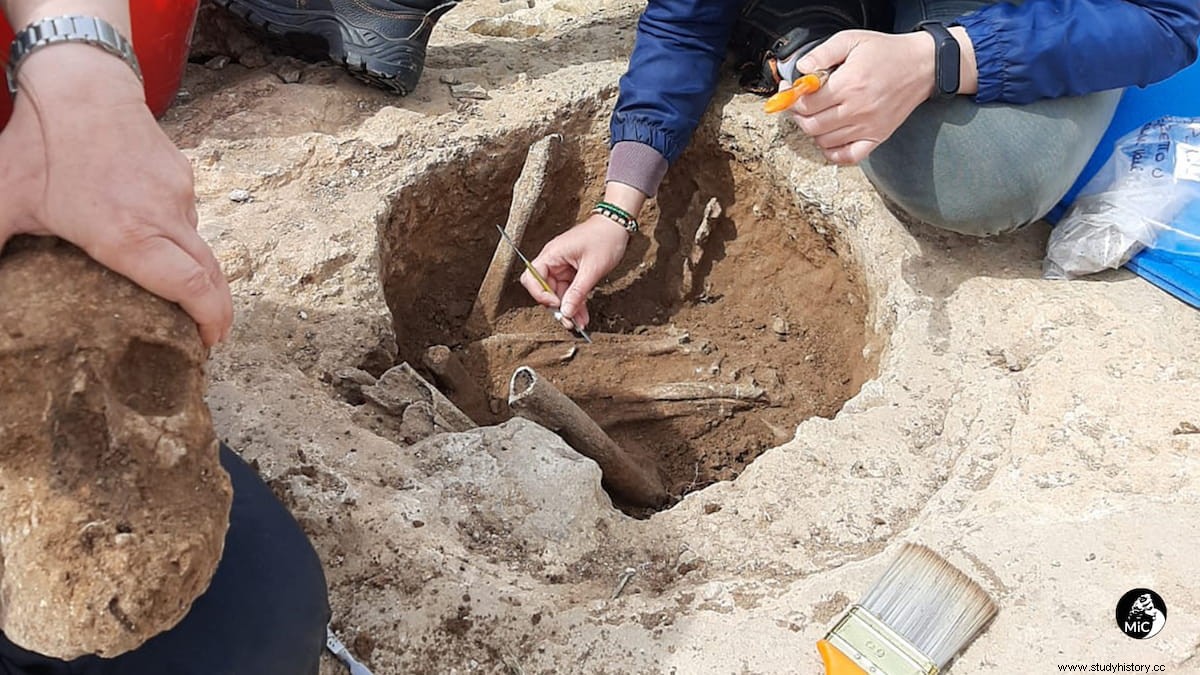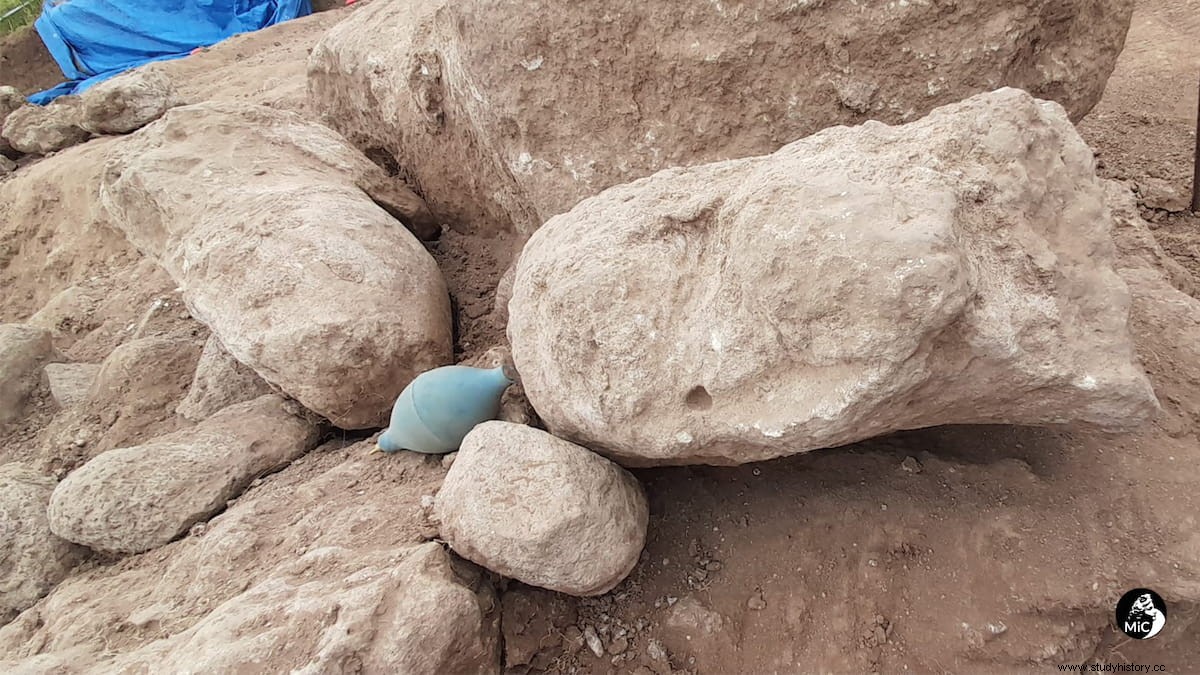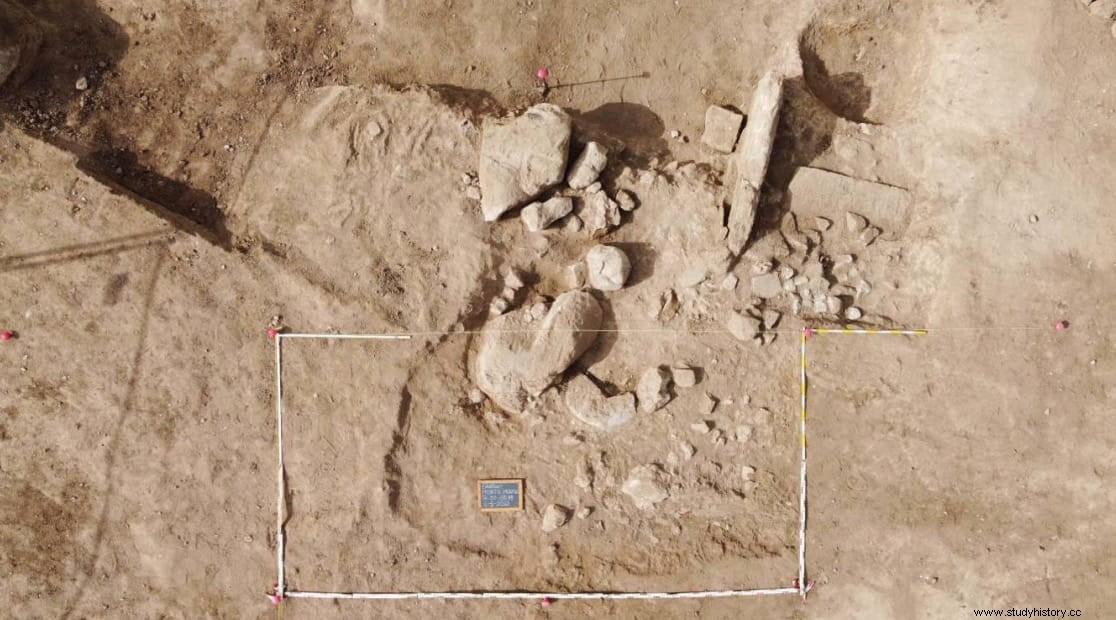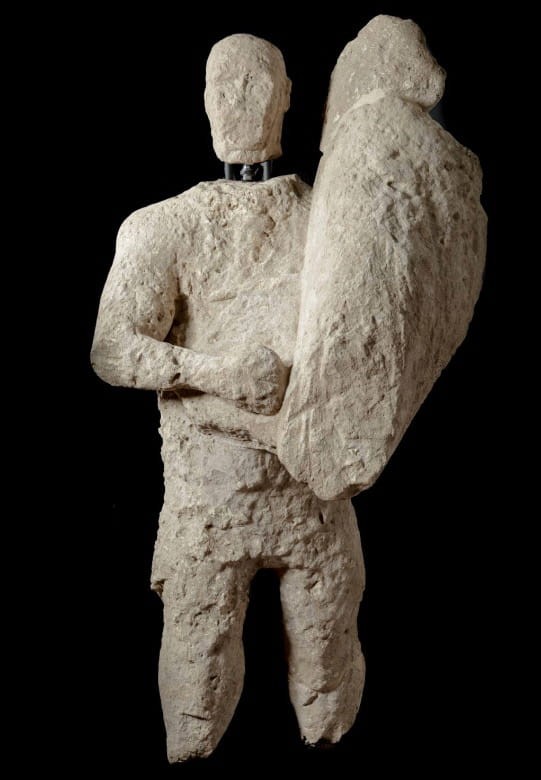Archaeologists working at the Mont'e Prama Nuragic necropolis site, in the municipality of Cabras on the island of Sardinia, have found the torsos and other fragments of two new statues, both identified as "Cavalupo-type boxers" by the large flexible shield that wraps around his torso, completely similar to the two sculptures recovered a few meters away in 2014 and now on display at the Cabras Civic Museum. The underlying layer also confirmed the southward continuation of the necropolis and the imposing funerary pathway, oriented on a north-south axis.
An exceptional discovery , said the Minister of Culture, Dario Franceschini, to be followed by others, confirming the important commitment of the Ministry to this extraordinary site, which has no equal in the Mediterranean . The discovery of two other giants, in fact, occurs less than a year after the creation of the Foundation, which sees how the Ministry of Culture, the Cabras City Council and the Region of Sardinia are committed to enhancing one of the greatest testimonies of an ancient Mediterranean civilization. Two new jewels are thus added to this statuary set of mysterious charm, capable of attracting the attention of the whole world .
The suggestive and mysterious set of the Giants of Mont'e Prama is thus enriched with two more units thanks to a discovery that surely will not remain isolated, given the promising quantity, quality and conservation conditions of the archaeological remains buried in the southern sector of the Nuragic necropolis.

While small and medium sized fragments are being highlighted daily, documented in their position on the ground, and recovered , said Superintendent Monica Stochino, the two large, heavy torso blocks will need time to be freed from the surrounding sediment and prepared for safe recovery . The discovery , he adds, rewards the perseverance and validity of the archaeological method of progressive exploration through phases of preliminary prospecting and systematic research, measured and carried out in the form and time allowed by the availability of resources and the parallel development of excavation projects, restoration and exhibition of the findings and enhancement of the site .
The current excavation work is the result of intense scientific and technical preparation led by archaeologists Alessandro Usai and Maura Varigiu, anthropologist Francesca Candilio, restorer Georgia Toreno, and architect Elena Romoli.

The mysterious fascination of the Nuragic Necropolis and the Giants of Mont’e Prama
Ancestral guardians of a sacred area, symbols of the social functions of the deceased, or the memory of an important event in local Nuragic history? Destroyed during an internal war between Nuragic communities, demolished by the Phoenicians or demolished by the Carthaginians? There are many mysteries that surround the Nuragic necropolis and the Giants of Mont'e Prama, finds that are unparalleled in the statuary of Nuragic Sardinia and that seem to be the product of an extreme exaggeration of the votive bronzes, implemented in a cultural context. crossed by deep lines of fracture in a moment of epochal transition that is deeply felt and suffered.
The most recent studies date the tombs and sculptures between the end of the 9th century and the first half of the 8th century BC, in the middle of the Iron Age, the work of a society that had changed radically compared to that of the Bronze Age. The Mont’e Prama necropolis went through three phases of use:the first consisted of single-pit tombs in which a buried body was deposited; the second consisted of new individual or grouped graves covered by stone slabs in a disorderly manner; the third consisted of tombs covered with square slabs, perfectly aligned.
Above these well-arranged tombs and in the open space in front of them, which constitutes a kind of burial path, statues were found in a fragmentary state, smashed already in antiquity and voluntarily deposited on top of and next to the tombs. At present, it is not possible to determine the original location of the statues, the fragments of which were found in a chaotic state. There are several hypotheses about their ancient location:some believe that the statues were placed in an area far from the tombs to delimit a sacred area; others think that they were placed in the area of the necropolis; Finally, there are those who think that they were placed on top of the slabs that covered the tombs.

Three main hypotheses have been proposed about its destruction:the first hypothesis considers the destruction of the complex as an episode of internal struggle between local communities of Nuragic culture; the second hypothesis is that the destruction took place at the hands of the Phoenicians of Tharros at the end of the 7th century BC; the third proposes that the destruction dates back to the second half of the fourth century BC. at the hands of the Carthaginians present on the island.
Theories about the meaning of the giants
According to one interpretation, the sculptures represented the highest social class, identifying archers with military values, boxers with religious ones, and nuraghi models with politicians. Another interpretation, on the other hand, recognizes in the statues, more than in the deceased themselves, the representation of their ancestors, evoked as mythical heroes of the Nuragic legends, and in the models of the nuraghi the symbol of the identity and unity of the community.

According to a last interpretation, finally, the statues could celebrate the memory of an important event of the Nuragic local history. The funerary and sculptural complex is usually defined as a heroon, that is, an organized and structured place for the worship of ancestors elevated to the rank of heroes. Thus, the sculptures of Mont'e Prama express identity and belonging, especially significant values in a time of transition characterized by profound tensions and transformations. They would therefore have a strong symbolic value, aimed at both local communities and those from the eastern Mediterranean, which in those years were off the coast of western Sardinia.
The research has been oriented towards two main objectives , explained superintendent Stochino, on the one hand to investigate some groups of burials from the oldest phase, Nuragic, and later Punic-Roman, in order to find the scientific information necessary for a reconstruction of the world in which they developed the cultural phenomena that led to the creation of the site; on the other hand, to extend the excavations to the south of the areas already investigated, with the aim of confirming the extension of the monumental layout of the area with the definition of the funerary route and the creation of the sculptural group formed by statues, models of nuraghi and betili .
According to the archeological officer Alessandro Usai, scientific director of the Sinis excavation since 2014, the two torsos found with the elongated shield that acquires a somewhat enveloping shape in relation to the left arm and flattens on the belly refer to the category of boxers . These are calcareous sculptures whose stone came from a quarry not far away, easy to sculpt but, for this very reason, also very fragile.
